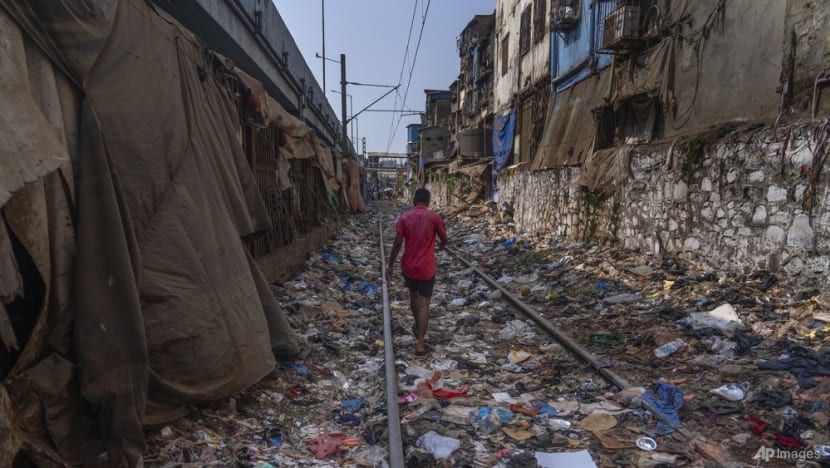Trash troubles: How India can deal with its staggering amount of plastic waste
One startup believes recycling is the way to counter the country’s growing problem.

A man walks on a railway track littered with plastic and other waste materials on Earth Day in Mumbai, India, April 22, 2024. (File photo: AP/Rafiq Maqbool)

This audio is generated by an AI tool.
NEW DELHI: India produces 9.3 million tonnes of plastic waste every year.
This is almost equivalent to the combined volume of what Nigeria, China and Indonesia - the next three biggest plastic polluters - generate.
Nearly half of this waste is made up of single-use plastics like water bottles, sachets, packaging and disposable cutlery.
With India's ban on some single-use plastic items two years ago doing little to curb the country's mounting waste problem, some startups - like Mumbai-based firm ReCircle - are taking matters into their own hands.
It works with a network of rag pickers to collect plastic waste, before sorting and processing the waste into tiny pellets that can be turned into other plastic products.
The firm’s co-founder Rahul Nainani believes recycling is the way to counter the growing problem.
While government statistics show that two-thirds of plastic waste in the country is recycled, the National Circular Economy Roadmap for Reducing Plastic Waste in India says otherwise - that the country’s total recycling rate could be closer to a mere 8 per cent.
"The only way to increase our recycling rates is by increasing segregation at (the) source so that material can be collected in a segregated manner and can reach the right processing facility, rather than reaching our landfills and oceans,” Nainani told CNA.
MISMANAGEMENT OF WASTE
According to the United Nations Environment Programme, India mismanages 85 per cent of its waste.
Some experts said India's plastic problem is a multi-faceted one, requiring a change in waste management practices as well as making sure policies are properly implemented.
In 2022, India outlawed 19 single-use plastic items such as plastic bags, cutlery and straws, which experts said was not a comprehensive enough measure.
Today, critics believe the ban is not being sufficiently enforced, allowing manufacturers and retailers to skirt the ban.
For the ban to be effective, people need education as well as advocacy to switch to alternatives, said independent environmental consultant Swati Singh Sambyal.
She added that there must be more effective monitoring and compliance systems.
However, reducing plastic waste is not top of mind for the poorest segments of society that are living hand to mouth.
Hari Ram Mukhiya’s small convenience store in a New Delhi slum caters to these groups, such as tuk tuk drivers and daily wage labourers.
His customers are used to getting plastic bags for free, unable to afford eco-friendly packaging or pay for carrier bags made from paper or cotton.
They also can only afford to buy smaller packets of goods and pay for what they need only when they need it.
“People here cannot spend 100 rupees (US$1.20) or 50 rupees at a time. They would rather buy sachets worth 1 rupee, and that’s all we sell,” said Mukhiya.
The use of sachets like these add to the plastic litter problem.
ADOPTING A WASTE-FREE LIFESTYLE
Many neighbourhoods in smaller cities and villages are seeing plastic waste piling up along roadsides, which blocks drains and rivers as well as poses risk to public health.
Such a dire state has compelled Delhi resident Sugeet Grover to adopt a relatively waste-free lifestyle.
He sorts his plastic packaging for re-use and, despite the convenience of doing so, avoids ordering items online to reduce his plastic usage.
He believes it is a reasonable trade-off.
“I have to think three times before I have a chocolate because I know that it’ll come in packaging. I’ll probably not be able to get an unpackaged chocolate very easily. So, there are certain things that I have to give up if I really have to maintain this lifestyle,” said Grover, a sustainable habitat researcher.
Analysts said the push for sustainability must also include poorer neighborhoods like Mukhiya’s, so that the world’s most populous country can emerge from its plastic trash troubles.

















